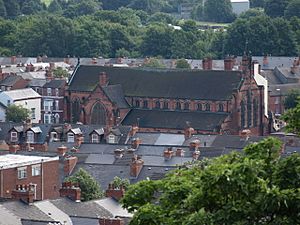St Christopher's Church, Sneinton facts for kids
Quick facts for kids St. Christopher's Church, Sneinton |
|
|---|---|
| The Church of St. Christopher with St. Philip, Sneinton | |
 |
|
| 52°57′00″N 1°7′29″W / 52.95000°N 1.12472°W | |
| Country | United Kingdom |
| Denomination | Church of England |
| Churchmanship | Open Evangelical |
| Website | achurchnearyou.com/sneinton-st-christopher |
| History | |
| Founded | Church of England |
| Dedication | St. Christopher |
| Consecrated | 1 December 1910 |
| Architecture | |
| Architect(s) | Frank Edwin Littler |
| Groundbreaking | 1909 |
| Completed | 1910 |
| Construction cost | £7,000 (equivalent to £512,100 in 2021) |
| Administration | |
| Parish | Sneinton |
| Diocese | Diocese of Southwell |
| Province | York |
St. Christopher's Church in Sneinton, Nottingham, is a beautiful Church of England church. It has a long and interesting history, including being rebuilt after a major event.
Contents
History of St. Christopher's Church
The church you see today was built on the same spot where an older "iron mission church" and school once stood. An iron mission church was a building made mostly of corrugated iron, often used as a temporary church or school.
Moving the Old Church
Before the new church could be built, the old school room, which was about 14 meters long and 6 meters wide, had to be moved. Workers carefully loosened it from its base. They used special beams and hydraulic jacks (like powerful car jacks) to lift the building. Then, they placed it on rollers and a team of 17 men slowly moved it about 12 meters away!
Two weeks later, the larger iron church itself was moved using the same clever method. This church was much bigger, about 25 meters long and 12 meters wide, and weighed between 60 and 80 tons. Even with its pews, organ, and other items still inside, it was moved about 21 meters. Imagine moving an entire building!
Building the New Church
The new St. Christopher's Church was designed in a style called "early Decorated Gothic." This style is known for its beautiful, detailed windows and decorations. The church has two side aisles and parts that stick out on the north and south sides, called transepts.
The church was officially opened and blessed on December 1, 1910, by Bishop Edwyn Hoskyns of Southwell. It took the place of the "tin church" that had been on the site since 1902. St. Christopher's became the main church, while the original church, built in 1885 on Meadow Lane, was kept as a smaller mission church.
Damage and Rebuilding
During World War II, Nottingham faced air raids, which were attacks by enemy planes dropping bombs. On May 8 and 9, 1941, a major air raid, known as the Nottingham Blitz, badly damaged St. Christopher's Church. Only the strong outer walls were left standing. The original church on Meadow Lane was also destroyed in this same attack.
Because of the damage, the church could not be used. For a while, the people of St. Christopher's joined with St. Philip's Church, Pennyfoot Street. After the war, St. Christopher's Church was rebuilt and restored. This work was finished in 1952. When St. Philip's Church was taken down in 1963, its name was added to St. Christopher's, which is why it is sometimes called "The Church of St. Christopher with St. Philip."
You can find more details about the church's history on the Southwell DAC Church History Project website.
Church Organ
The church has a special musical instrument called a two-manual pipe organ. It was made by a company called Cousans of Lincoln when the church was rebuilt in 1953. An organ is a large instrument that uses air blown through pipes to make sound. The "reeds" (a part of the organ that makes certain sounds) were tuned by a person named Billy Jones.
If you are interested in learning more about this specific organ, you can find its details on the National Pipe Organ Register website.

